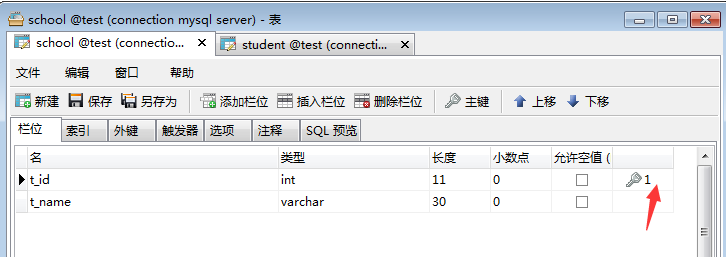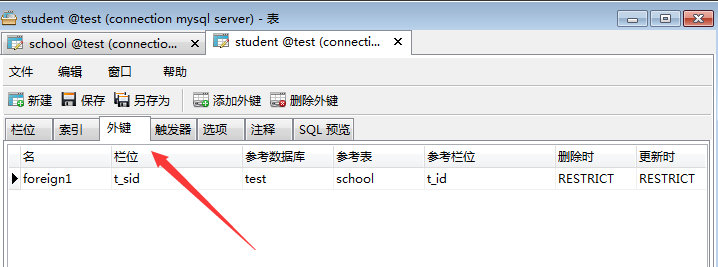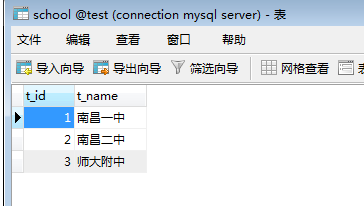Mybatis(四)关联映射
一. Mybatis关联映射
1 讲数据库中关联关系,主键表与外键表
一对多,多对一,主键表表示一 与外键表表示多
学生与学校的关系,工人与工厂,人员与部门的关系,。。。。
多 一 多 一 多 一





2 多表查询
多表查询 方法一
select a.*,b.* from student a,school b where a.t_sid=b.t_id
select a.*,b.t_name from student a,school b where a.t_sid=b.t_id
select a.*,b.t_name from student a,school b where a.t_sid=b.t_id and b.t_id=1
多表查询 方法二
select student.*,school.* from student inner join school on student.t_sid=school.t_id
select student.*,school.t_name from student inner join school on student.t_sid=school.t_id
select student.*,school.t_name from student inner join school on student.t_sid=school.t_id and school.t_id=1
3 mybatis多对一
要查询多个表中信息:有三种方法:
方法一:
<resultMap type="com.softjx.model.Student" id="StudentMap1">
<result column="t_id" property="id"/>
<result column="t_name" property="studentName" />
<result column="t_age" property="age"/>
<result column="t_enterdate" property="enterDate"/>
<result column="t_sid" property="sid"/>
<!—关联字段-->
<result column="t_id1" property="school.id"/>
<result column="t_name1" property="school.schoolName"/> </resultMap> <!-- 根据id查询数据表中的一条记录 -->
<select id="getStudentId1" resultMap="StudentMap1">
select a.t_id,a.t_name,a.t_age,a.t_enterdate,a.t_sid,b.t_id as t_id1,b.t_name as t_name1 from student a,school b where a.t_sid=b.t_id and a.t_id=#{id};
</select>
方法二:使用association定义关联的单个对象
<resultMap type="com.softjx.model.Student" id="StudentMap2">
<result column="t_id" property="id"/>
<result column="t_name" property="studentName" />
<result column="t_age" property="age"/>
<result column="t_enterdate" property="enterDate"/>
<result column="t_sid" property="sid"/>
<!-- association可以指定联合的javaBean对象
property="school":指定哪个属性是联合的对象
javaType:指定这个属性对象的类型[不能省略]
-->
<association property="school" javaType="com.softjx.model.School">
<id column="t_id" property="id"/>
<result column="t_name" property="schoolName"/>
</association>
</resultMap> <!-- 根据id查询数据表中的一条记录 -->
<select id="getStudentId2" resultMap="StudentMap2">
select a.t_id,a.t_name,a.t_age,a.t_enterdate,a.t_sid,b.t_id as t_id1,b.t_name as t_name1 from student a,school b where a.t_sid=b.t_id and a.t_id=#{id};
</select>
方法三:使用association进行分步查询
1)、先按照t_id查询学生信息
2)、根据查询学生信息中的t_sid值去学校表查出学校的信息
3)、学校信息设置到学生中;
1、先按照t_id查询学生信息
2、根据查询学生信息中的t_sid值去学校表查出学校的信息
3、学校信息设置到学生中; <resultMap type="com.softjx.model.Student" id="StudentMap3">
<result column="t_id" property="id"/>
<result column="t_name" property="studentName" />
<result column="t_age" property="age"/>
<result column="t_enterdate" property="enterDate"/>
<result column="t_sid" property="sid"/>
<!-- association定义关联对象的封装
select:表明当前属性再去调用哪个方法查出的结果
column:指定根据当前表中哪一列的值传给这个方法
流程:使用select指定的方法查出对象,并封装给property指定的属性
-->
<association property="school"
select="com.softjx.dao.SchoolMapper.getSchoolId"
column="t_sid">
</association> </resultMap>
使用association进行分步查询,可以是立即加载,延迟加载;
可以使用延迟加载(懒加载);(按需加载)
Student==>School:
我们每次查询Student对象的时候,都将一起查询出来,(立即加载)。
学校信息在我们使用的时候再去查询(延迟加载);
分段查询的基础之上(懒加载)加上两个配置在全局配置文件中config.xml:
<settings> <setting name="lazyLoadingEnabled" value="true"/> <setting name="aggressiveLazyLoading" value="false"/> </settings>
4 mybatis一对多
方法一:使用collection标签
1)在学校中有一个集合类型,指向多个学生
private List<Student> students;
public List<Student> getStudents() {
return students;
}
public void setStudents(List<Student> students) {
this.students = students;
}
2)在SchoolMapper.xml文件中配置collection标签,标签中ofType:指定集合里面元素的类型,property:指定bean的属性名。
<resultMap type="com.softjx.model.School" id="SchoolMap1">
<result column="t_id" property="id"/>
<result column="t_name" property="schoolName" />
<!--
collection定义关联集合类型的属性
ofType:指定集合里面元素的类型
-->
<collection property="students" ofType="com.softjx.model.Student">
<!-- 定义这个集合中元素的封装规则 -->
<result column="t_id1" property="id"/>
<result column="t_name1" property="studentName" />
<result column="t_age" property="age"/>
<result column="t_enterdate" property="enterDate"/>
<result column="t_sid" property="sid"/>
</collection>
</resultMap> <select id="getSchoolId1" resultMap="SchoolMap1">
select b.t_id as t_id,b.t_name as t_name ,a.t_id as t_id1 ,a.t_name as t_name1,a.t_age,a.t_enterdate, a.t_sid from school b, student a where b.t_id=a.t_sid and b.t_id=#{id}
</select>
方法二:使用collection分段:
1)首先要根据学校编号在学生表中查询所有学生:
<!-- 根据学生的学校id查询所有的学生 --> public List<Student> getStudentsBySchoolId(Integer sid); <select id="getStudentsBySchoolId" resultMap="StudentMap">
select * from student where t_sid=#{sid};
</select> 注意:这个sid是collection标签中要访问的。
2)Collection分段代码:
<!-- sid是方法的参数名,t_id是字段名 -->
<resultMap type="com.softjx.model.School" id="SchoolMap2">
<result column="t_id" property="id"/>
<result column="t_name" property="schoolName" />
<collection property="students"
select="com.softjx.dao.StudentMapper.getStudentsBySchoolId"
column="{sid=t_id}" fetchType="lazy">
</collection>
</resultMap> <select id="getSchoolId2" resultMap="SchoolMap2">
select * from school where t_id=#{id}
</select>
注意:
1)fetchType="lazy":表示使用延迟加载,默认是延迟;它的取值是 lazy:延迟加载,eager:立即加载。
2)多列的值传递:
column="{key1=column1,key2=column2}",key1是方法的参数名,column1是字段名, key2是方法的参数名,column2是字段名。
5 mybatis一对多,多对一(使用注解)
1)mybatis全局配置文件要应用接口类:
<mappers>
<mapper class="com.softjx.dao.SchoolMapper"/>
<mapper class="com.softjx.dao.StudentMapper"/>
</mappers>
2)没有mapper.xml文件,只有接口文件:
多对一关系:
//根据id查询学生,包括学生的学校
//property="school",column="t_sid" column是当前表中关联字段名t_sid
//查询一个用户
@Select("select * from student where t_id=#{id}")
@Results({@Result(property="id",column="t_id")
,@Result(property="studentName",column="t_name")
,@Result(property="age",column="t_age")
,@Result(property="enterDate",column="t_enterdate")
,@Result(property="sid",column="t_sid")
,@Result(property="school",column="t_sid",one=@One(select="com.softjx.dao.SchoolMapper.getSchoolId",fetchType=FetchType.EAGER)) })
public Student getStudentId1(Integer id);
一对多的关系:
1.先要在多这一方查询数据。 //根据学生的学校id查询所有的学生
@Select("select * from student where t_sid=#{sid}")
@Results({@Result(property="id",column="t_id")
,@Result(property="studentName",column="t_name")
,@Result(property="age",column="t_age")
,@Result(property="enterDate",column="t_enterdate")
,@Result(property="sid",column="t_sid")
})
public List<Student> getStudentsBySchoolId(Integer sid); 2.
//根据id查询学校
//property="students",column="t_id" column是当前表中的主键字段名t_id
@Select("select * from school where t_id=#{id}")
@Results({@Result(property="id",column="t_id")
,@Result(property="schoolName",column="t_name")
,@Result(property="students",column="t_id",many=@Many(select="com.softjx.dao.StudentMapper.getStudentsBySchoolId",fetchType=FetchType.LAZY))
})
public School getSchoolId1(Integer id);
Mybatis(四)关联映射的更多相关文章
- 04—mybatis的关联映射
mybatis的关联映射一对一一对多多对多 一.一对一(一个人只能有一个身份证号) 1.创建表创建表tb_card CREATE TABLE `tb_card` ( `id` int(11) NOT ...
- mybatis 一对一关联映射实例
在实际项目开发中,经常存在一对一的关系,如一个人对应一张身份证信息,这就是一对一的关系.下面是一个简单的实例: 1.建表过程我就省略了,主要是一张Person表,一张IDCard表,其相关属性见步骤2 ...
- mybatis之关联映射
###mybatis使用之一对一关联映射 1)分析并画ER图.(特别是一对一.一对多.多对多的情况) 2)启动终端数据库,并建库建表,在表中插入值和字段,并查看结果.(后期把navicat用上) 3) ...
- Mybatis的关联映射案例
主要是对之前学习的关联映射做一个案例,自己动手实践一下,可以理解的更好一点. 开发环境 开发工具:idea Java环境: jdk1.8.0_121 数据库:SQLServer 项目结构,里面包含了三 ...
- Mybatis的关联映射
实际的开发中,对数据库的操作常常会涉及到多张表,这在面向对象中就涉及到了对象与对象之间的关联关系.针对多表之间的操作,MyBatis提供了关联映射, 通过关联映射就可以很好的处理对象与对象之间的关联关 ...
- Mybatis(四) 高级映射,一对一,一对多,多对多映射
天气甚好,怎能不学习? 一.单向和双向 包括一对一,一对多,多对多这三种情况,但是每一种又分为单向和双向,在hibernate中我们就详细解析过这单向和双向是啥意思,在这里,在重复一遍,就拿一对多这种 ...
- MyBatis的关联映射和动态SQL
CREATE TABLE tb_card ( id INT PRIMARY KEY AUTO_INCREMENT, CODE ) ); '); CREATE TABLE tb_person ( id ...
- 【Hibernate框架】关联映射(一对一关联映射)
一.整理思路: 之前,小编总结过Mybatis的关联映射,接下来,再来总结一下hibernate的相关的关联映射,直接上图: 这张图,就是小编整理总结整个Hibernate的关联映射的一个大致思路. ...
- MyBatis学习(七)MyBatis关联映射之多对多映射
对于数据库中的多对多关系建议使用一个中间表来维护关系. 1.创建四张表,分别为用户表,商品表,订单表,中间表. DROP TABLE IF EXISTS `t_user`; CREATE TABLE ...
随机推荐
- 【转】scatterlist && DMA
原文:scatterlist && DMA DMA是一种无须CPU的参与就可以让外设与系统内存之间进行双向数据传输的硬件机制.使用DMA可以是系统CPU从实际的IO数据传输过程中摆脱出 ...
- 正确理解Mysql的列索引和多列索引
MySQL数据库提供两种类型的索引,如果没正确设置,索引的利用效率会大打折扣却完全不知问题出在这. CREATE TABLE test ( id INT NOT NULL, last_ ...
- css实现的交互运动
<style type="text/css"> .filter-mix { position: absolute; top: 50%; left: 50%; trans ...
- Xcode9 FFmpeg冲突问题
升级Xcode9之后,工程中FFmpeg中的avutil.h下的AVMediaType与系统的AVFoundation框架冲突了. 报错信息:Typedef 'AVMediaType' cannot ...
- 跨站请求伪造(CSRF)-简述
跨站请求伪造(CSRF)-简述 跨站请求伪造(英语:Cross-site request forgery),也被称为 one-click attack 或者 session riding,通常缩写为 ...
- sed命令详解 vim高级技巧 shell编程上
第1章 sed命令详解 1.1 查找固定的某一行 1.1.1 awk命令方法 [root@znix ~]# awk '!/oldboy/' person.txt 102,zhangyao,CTO 10 ...
- Android 开发笔记___复选框__checkbox
<LinearLayout xmlns:android="http://schemas.android.com/apk/res/android" android:layout ...
- vue初级学习--环境搭建
一.导语 最近总想学点东西,es6啊.typescript啊,都想学,刚好有个机遇,可以学点vue,嗯,那就开始吧. 二.正文 1.node环境: 下载安装nodeJs,最好是1.6以上的版本,下载地 ...
- Ubuntu系统下静态DNS配置详解
1.DNS服务的简介: DNS(Domain Name Server,域名服务器)是进行域名(domain name)和与之相对应的IP地址 (IP address)转换的服务器.DNS中保存了一张域 ...
- .net表达式计算器(中缀表达式转后缀表达式,支持20多个数学函数,支持函数嵌套)
最近在网上查了一下表达工计算器的类库,发现Java版本的有一个比较成熟的叫W3EVal,好像是一个IBM工程师写的,.net就很少了(可能是我了解不够多),但投机取巧的实现思路有很多,比如: (1)将 ...
